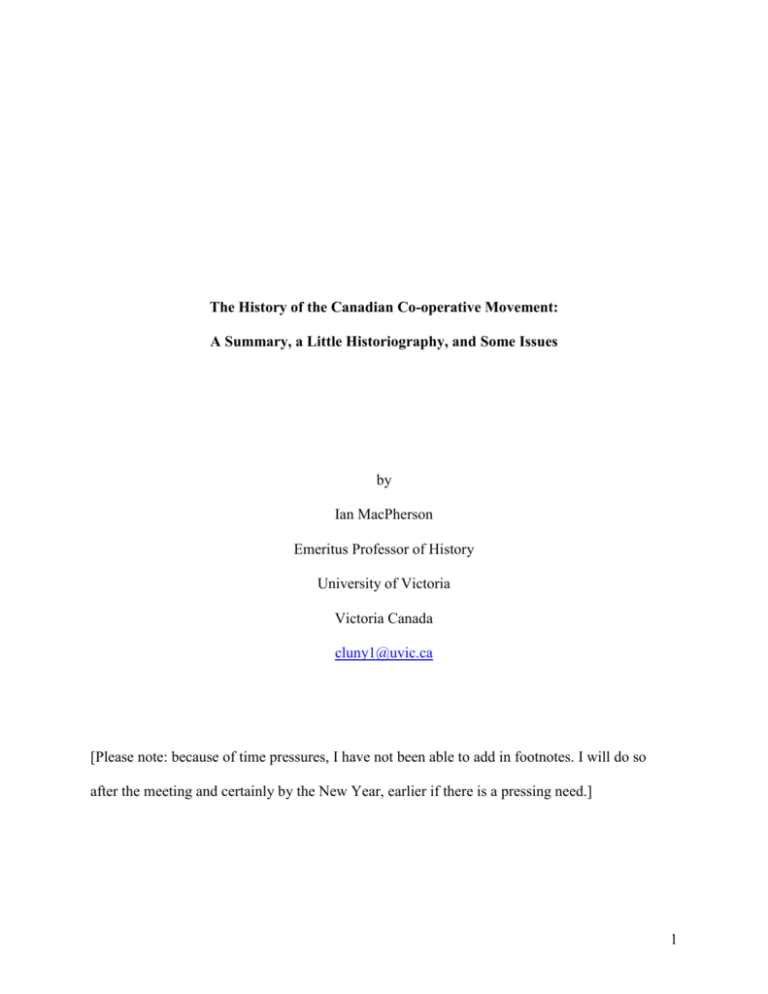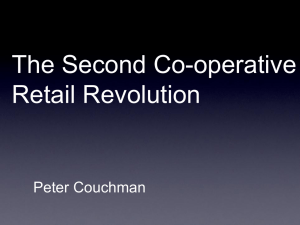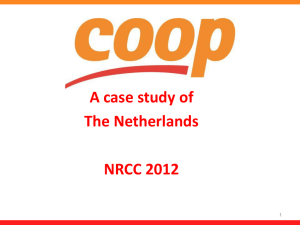The History of the Canadian Co
advertisement

The History of the Canadian Co-operative Movement: A Summary, a Little Historiography, and Some Issues by Ian MacPherson Emeritus Professor of History University of Victoria Victoria Canada cluny1@uvic.ca [Please note: because of time pressures, I have not been able to add in footnotes. I will do so after the meeting and certainly by the New Year, earlier if there is a pressing need.] 1 Canadian Co-operative History – A Brief Introduction 1. Beginnings. It is traditional to date the beginnings of co-operative movements with the establishment of organisations that can be reasonably recognized as co-operatives. Using that approach, one can date the beginnings of the formal movement to the development of mutual insurance companies to the 1840s. They were followed in the next decade by the beginnings of cheese factories throughout much of southern Central Canada and, somewhat later, in parts of Atlantic Canada. The first known consumer co-operative was organized at Stellarton, Nova Scotia, in 1864, though there may have been some unregistered efforts earlier, perhaps as early as the 1820s. A case can be made that the first co-operative bank was organized in Prince Edward Island in North Rustico in 1864. Certainly, its spirit was co-operative and it base in community was strong. Worker co-operatives had their beginnings with the Knights of Labour, a working class trade union and social movement in the 1880s. It should be noted that all these beginnings took place before there was specific, enabling co-operative legislation; before there was any general acceptance of international co-operative principles; and before regulators had any significant understanding about the nature of cooperative enterprise. In short, the early experiments were just that – experiments undertaken by groups working within flexible and developing company law to create institutions to meet their needs and likings; in some instances at least, though, they were attempting to imitate European precedents. 2. Institutional development and informal or traditional co-operation. A significant issue in thinking particularly about beginnings but also about the sustained ongoing strength of cooperatives, is the association with traditional co-operation (e.g., the ritual co-operation typically 2 found in most rural areas at the time of planting and harvesting) and spontaneous co-operation (when groups, perceiving opportunities, collaborate for joint purchase of supplies or the sale of produce). Much of this kind of co-operation is informal, but it is important for the beginnings and the subsequent development of formal co-operative institutions. It provides context, networks, and bonds of association without which many co-operatives would not have succeeded, particularly in their formative and stabilizing phases. In that sense, it is misleading to think that an institutional approach to understanding co-operative movements is fully satisfactory. The “movement” has a life beyond institutions, often stretching deeply into cultural, community, kinship, and class relationships. The movement is not easily measured. This is a challenge for historians. 3. The agricultural movements. Until the 1950s, the co-operative movement was most readily found in rural Canada. The first major wave of agricultural co-operatives was in the dairy industry, partly an outgrowth of the work of agricultural societies but, more importantly, because dairying pr4esented some obvious opportunities because it was so widespread: most farms had 57 head of cattle and, typically, some excess production of milk for sale. As transportation links developed, notably railways, the opportunities to sell dairy products, including butter and cheese, grew. It became commonplace, therefore, for 15-20 farm families to join together to build “butteries” and cheese “factories” to meet the needs of the growing cities of the nineteenth century. In total, some 3,000 such local “patron” organisations were developed. Cheese in particular became a major export to the United Kingdom when refrigerated shipping became commonplace in the later nineteenth century. It was Canada’s most important agricultural export until the grain districts on the Prairies were developed at the end of the nineteenth century. 3 The rural co-operative movements were closely tied to a succession of agrarian movements that were a feature of Canadian life from the 1870s onward until the middle of the twentieth century. The main movements were: the Patrons of Husbandry (1870s), the Patrons of Industry (1890s), the grain growers’ movements (1900-1930), and the associated Progressive movement (1914-1930). They were also important in the development of particularly the western branches of the Co-operative Commonwealth Federation and of Social Credit, two third party movements of the 1930s. All of these agrarian movements fostered the development of co-operatives of different kinds to meet the needs of rural people and their communities. Rural co-operatives, however, were primarily organized to meet both supply and marketing needs. They were particularly important in the process of western settlement from the late nineteenth century through the 1920s. The story of their development is complex, spanning a number of organisations, some primarily economic, others primarily agrarian; some frankly political, others not. The most dramatic co-operative development in Canadian co-operative history occurred in the grain belt during the 1920s with the pooling crusade, which swept the grain producing regions of the Canadian Prairies and influenced the development of cooperatives among other commodity producers both there and in other regions. The co-operative movements of Prairie Canada were central institutions in the region’s development from 1900 to 1940. They became vitally important political issues, and central to the growth of the rural sector in the region. Nor were the rural co-operatives of the region initially narrow or isolated in their approach; many of them were involved in the development of co-operative stores serving rural communities, the organisation of credit unions, the development of insurance services, the beginnings of trust services, and the early experiments with community-based health services. Until the 1950s, they demonstrated a breadth of vision that 4 was truly remarkable, particularly in Saskatchewan but moreso in Alberta and Manitoba than is commonly recognized today. Since the 1950s, most of the agricultural co-operatives have gradually lost their interest in wider rural issues and in participating actively in the wider co-operative movement. Their cooperative vision has generally been narrowed to commodity and institutional concerns. This is a reflection of the complexities associated with the unequal growth of farms, the drastic weakening of rural communities, the accumulating pressure emanating from the internationalisation of the agro-food industries, and the nature of the leadership (elected and employed) that emerged within them. This development has facilitated the demutualization of a number of what were major agricultural co-operatives in the grain and dairy industries. The demutualization of those firms, however, should not be taken to mean that the cooperative movement is disappearing from the countryside. According to statistics gathered by the Co-operatives Secretariat in the federal government, there are currently over 1,000 agricultural co-ops serving rural needs across Canada.i In recent years, too, there have been a number of new co-operatives formed serving organic farmers, responding to concerns about food, the marketing of produce directly to consumers, meeting rural social needs, providing energy, addressing transportation requiremesntrd, and helping small farmers secure the technological capacity they require to maximise production. Several recent shifts in farming, land utilisation, and changing consumer preference tend to favour the development of co-operatives today, though it is perhaps premature to evaluate their long-term impact. There are also interesting links with similar groups in other countries, links that are somewhat reminiscent of the kinds of international contacts that helped precipitate so much rural co-operative activity during the 1920s. Another interesting dimension of the most recent rural co-operative growth is the way in which many new co- 5 operatives are bridging with consumers; the old producer-consumer split that bedevilled the movement for decades is not as evident as it was with the development of agricultural co-ops: there is some effort at common cause, though the relationships are just in their early stages of development so one should not judge hastily. 4. The Consumer Movement. The consumer movement had a long and difficult birth in Canada. It was largely imported by immigrants – part of the cultural baggage of the migrating European working class. Most of the early co-operatives were developed by British, Finnish, Italian, and Ukrainian workers, most commonly in the mining towns of Cape Breton, Northern Ontario, the Rocky Mountains and Vancouver Island. The British workers were the most prominent of these early immigrant co-operators and the British model of co-operative development, especially the consumer theory of co-operation, was generally dominant. The consumer movement was nurtured along by the Co-operative Union of Canada (organized in 1909) and particularly by its General Secretary for its first 34 years, George Keen, a native of Stoke-on-Trent. He helped create a loosely linked group of co-operative stores across the nation and to assist in the development of provincial wholesales in western Canada in the late 1920s. He also helped in the development of co-operative legislation at the provincial level during his years as General Secretary, efforts to create national level having failed, despite a series of efforts, prior to World War One. The western co-ops, organized under the umbrella of Federated Co-operatives Limited, have built a very successful enterprise; financially, the wholesale is one of the strongest business organisations in western Canada. Much of its business success can be attributed to its involvement in the petroleum business through a substantial refinery it has developed in Regina over the years. 6 The consumer movement developed in significantly different ways across Canada, important because it has generally advocated the most cohesive and inclusive form of cooperative activity. It developed most strongly in western Canada, particularly on the Prairies but also in British Columbia. It never developed strongly in Ontario or Québec, despite periodic attempts. The usual explanations for the several failed beginnings are: the power of the chain stores, the uncertain relationships with rural co-operatives, the heavy urbanisation that overwhelmed community feelings, kinship and religious ties were less powerful, and the kinds of individualism that came to dominate, particularly in the urban centres made organizing difficult. The movement was much stronger in Atlantic Canada, where the Antigonish Movement (see below) effectively supported it, local communities had strong senses of identity, and the competition was obviously exploitive but (until the last 15 years) structurally weak. The Atlantic movement has typically embraced a wide co-operative vision though its capacity to implement many of the programmes in which it is interested is severely limited today by a tightening competitive situation. In Canada, the consumer movement generally has been the most supportive of broader cooperative visions and of the need to support provincial and national apex organisations. Despite generational social differences, they have also been good supporters of new co-operative initiatives. 5. The Financial Co-operatives. The first caisses populaire was formed in 1900. Using connections within the Roman Catholic Church and with key political figures, Alphonse Desjardins laid the groundwork for an extensive provincial movement before his death in 1920. He also attempted to start a similar movement in Ontario, but it grew slowly, restricted to a few parishes and Francophone public servants. When the credit union movement came to Ontario, it 7 certainly borrowed from the Desjardins experience, but it was primarily from the American credit union movement and its model for development. George Keen and the Co-operative Union of Canada played a role in its early development, but the Antigonish Movement played a greater role in the growth the movement experienced in the 1930s, 40s and 50s. The movement spread across English-Canada in those years, organized on a provincial basis, largely because credit unions were incorporated under provincial legislation and regulated by provincial authorities. The Francophone and Anglophone co-operative financial movements have developed largely in isolation from each other, though relations have nearly always been cordial and frequently mutually supportive. The Québec movement encountered significant financial pressures during the Great Depression and responded to them by becoming highly centralized, a characteristic it retained even after the financial difficulties had subsided. The movement in English-Canada remained largely decentralized as it grew steadily after World War One, though there were always significant debates over how the movement should develop its provincial and national structures. One dimension of this debate was the ambivalent relationship the Canadian movement had with the older and larger movement in the United States. There were significant variations within provincial movements and among provincial movements in how closely they related to the American credit unionism. The distinguishing features of the American movement were: an emphasis on supporting credit unions having strong, workplace, ethnic and religious bonds of association, a loose connection with other forms of co-operatives, and strong loyalties to the central institutions they created, particularly CUNA Mutual Insurance Company. In Canada there were many credit union leaders who were closely tied to other kinds of co-operatives, a significant difference. Moreover, Canadian credit unions, particularly outside of Ontario, which 8 tended to be strongly imitative of the American precedence, were often oriented towards general community concerns; they organized community-based credit unions as a result, an innovation viewed suspiciously by many American leaders until the 1970s and 1980s. These differences were exacerbated from the 1950s through the 1970s by an intense debate over the development of a distinctive Canadian financial co-operative system. Insuring member loans and deposits of credit union members was a lucrative economic activity and it was an attractive aspect for credit union members, many of whom were not eligible for insurance or could not otherwise afford it. Several Canadian leaders wanted to enter that field. They were interested in building co-operative insurance as a way of developing a financial nexus for cooperative development. They envisioned creating insurance companies that, in addition to serving credit union members would also provide property and auto insurance. Thus in the Prairies and Ontario, co-operative leaders formed insurance companies (under Canadian legislation it was impossible to form co-operatively-owned insurance companies). Given the intensity of the debates that emerged about savings and loans insurance, they did not immediately enter into the credit union business and that issue would remain, albeit gradually muting until this year when Co-operators took over all of the savings and loans activities in Canada. In Québec, where there the Mouvement Desjardins did not have associations with the American movement, there were no reasons to abstain and they developed a full range of cooperative insurance services at about the same time. The Québec movement had far fewer complexities in trying to develop central and service institutions. In recent years, the caisses populaires/credit union movement has witnessed extensive change related to the far reaching transitions in the financial industries. The most obvious 9 manifestation of this in the English-Canadian movement has been the widespread pursuit of amalgamations and mergers of credit unions, attributable to the increasing costs of new technologies, the savings brought about by centralizing support systems, the need to meet member demand for expanded services, and responding to the ambition of credit union leaders, elected and salaried. Today, the top 100 credit unions in Canada control over 80% of the system’s assets.ii In Québec the same forces have led to the expansion of local caisses (for many years, their size had been capped so as to avoid the politics of size differential and to emphasize local services). The Mouvement Desjardins has also entered aggressively into the rest of Canada, marketing its credit card services to credit unions, purchasing bank branches as a way to build networks, and promoting itself in a variety of ways. It has even opened up caisses in Florida where many Québéçois holiday each year. These moves follow a period in which Desjardins considered seriously how to expand its international presence, one of the first Canadian cooperatives to consider seriously the possibilities of international business opportunities. 6. Co-operative Housing. While tours by Henry Vivian prior to and during World War One aroused some interest in co-operative housing as part of the Garden City movement, it was not until the 1930s that the movement gathered momentum. During that decade mining families in Nova Scotia faced serious housing problems: company housing was notoriously bad and the housing stock was insufficient to meet the demand. Leaders from the Antigonish movement had heard about the extensive co-operative housing movement in New York. They invited Mary Arnold, one of the more important housing leaders in New York, to come to Cape Breton and promote housing co-ops. The outcome was not housing co-operatives as generally understood 10 but co-operatives of families uniting to build housing for themselves. Before the movement had run its course, over 30,000 houses would be built in Atlantic Canada. In the same decade, more conventional, continuing co-operative housing began to appear among students at the University of Toronto. With the help of George Keen, they began an extensive programme of student housing co-ops in Toronto. Over time, students at Queen’s University, Waterloo University, and Ottawa University would emulate their efforts. Today, it is a modest but successful movement. Following World War Two, groups of Canadians in the major cities independently organized housing co-operatives to meet their housing needs and/or to create the kinds of communities in which they wished to live. This pattern of independent communitarian housing picked up during the 1960s and 1970s, by-products of the social unrest of the period, particularly among youth and people protesting the Vietnam War . The major housing co-operative movement, however, emerged because several co-op leaders had seen co-operative housing in Europe and the United States. As our cities grew and social problems became commonplace, some of them looked to co-operative housing to help Canada avoid the urban blight and extreme poverty they could readily find in the large American cities. The Co-operative Union of Canada collaborated with the Trades and Labour Congress to promote co-operative housing as a way to offset these problems. In 1973, Central Mortgage and Housing Corporation, the federal government’s housing arm, announced a new programme that essentially helped fund co-operative housing by guaranteeing a low income rate on mortgages, an important contribution because of the wildly fluctuating interest rates that occurred later in the decade. It also encouraged the development of resource groups to help form effective co-op housing projects for people with mixed income levels, one of the objectives being to create 11 multi-faceted communities, with people having different skill sets and income levels. The programme developed quickly in many of the major urban centres of Canada, and a few of the smaller ones. In the later 1980s, as the political climate inexorably changed in Canada, conservative groups began to criticize the housing co-ops for harbouring, they claimed, people who were receiving a subsidized benefit. It was a claim made more out of ideological assumptions than demonstrable, informed truth. It nevertheless had the effect they desired and government support for co-operative housing declined. It ended in the early 1990s. Currently, the mainstream housing co-operative movement is dealing with the process of renewal of its older housing stock. Many of the co-operative housing projects built in the 1970s and 1980s have now paid off their mortgage. It is to the credit of the movement that those who happen to be living in co-operative housing today have generally decided to forego “flipping” their projects. Instead, they have remortgaged to restore their units and several of them have been searching for ways to use their accumulated assets to help in the development of further cooperative housing, 7. Worker Co-operatives. Following the short-lived efforts of the Knights of Labour to develop worker co-ops in the 1880s, there were spasmodic, highly local efforts to develop this form of co-operation in the twentieth century. Then, in the economic expansion after World War Two, various groups started to engage the idea of worker co-operatives seriously. The most extensive groupings were in Québec in the forestry industries. Workers who sold their services to farmers wanting to harvest their woodlots found it useful to develop co-operatives. Today, they form the largest grouping of worker co-operatives in Canada. 12 In the 1960s and 1970s groups concerned about consumer and workplace issues began to appear in Montréal, Toronto, Vancouver and Victoria. They formed a number of worker co-ops to sell organic foods, but in more recent years have helped develop co-ops in the energy sector, bakeries, the travel business, crafts, nightclubs, restaurants, seafood, greenhouses, and tourism. They have also created service co-ops, most particularly to work with seniors and, in Québec to provide ambulance services. A common issues often associated with worker co-op is the wish to provide voices for multiple stakeholders. In Québec, this desire has led to the development of legislation for what are called “Solidarity Co-ops”, co-operatives that include representation on the board for all those seriously involved directly in the co-op, including community groups. It is part of a common questioning of the standard co-operative models that were developed in the nineteenth century. Is this an issue we should think about? 8. Fishing co-operatives. Fishing co-operatives have a long history in Canada, stretching back to the 1920s. The Antigonish movement began as an effort to help fishing communities on the East Coast cope with difficult marketing situations and viciously exploitive practices by fish merchants. They helped build a highly decentralized movement based largely on the strength of village associations in both Francophone and Anglophone communities. The result was that the movement always wrestled with problems of building and sustaining its federation and in maintaining providing a united, effective front to governments and the industry generally. Fishing folk are not easily organized. That meant that, in the 1970s and 1980s the co-ops were unable to convince the federal government of the need to protect the inshore fisheries, in which they largely worked, from the competition of large trawlers and canning ships from other countries. As for the government, it believed it was better to encourage populations to shift from 13 out ports to large population centres, in part so that welfare state programmes could be more easily and cheaply administered; in part, because officials believed life would be “richer” there. The result was the unbelievably rapid decline in fishing stocks and the destruction of inshore as well as off-shore fisheries in the 1980s. The East Coast co-ops were reduced to a few serving mostly Acadian fishing folk in New Brunswick and Nova Scotia. It is a complex and arresting story with several important issues for co-operative history, including problems of governance, relationships with technology, policy development, and the impact of globalisation. It is a story that has not been adequately told. Fishing co-operatives began at about the same time on the West Coast; indeed, the Antigonish movement can take some of the credit for their early development, two of its fieldworkers helping in the movement’s early growth in the 1930s. Mostly, though, they emerged because of the work of the fishing unions and the strong associational spirit of ethnic fishing folk. Gradually, most of the co-ops came together under the flag of the large fishing co-operative located in Prince Rupert on the northern coast of British Columbia. At its height, it controlled over 40% of the fish products emanating from this most prominent fishing community in the province. Its canning factory dominated the skyline. It provided a high standard of living for its fishers and good seasonal employment for the hundreds employed in the plant. Its leaders became important figures in the Canadian movement generally and its general manager, Ken Harding, became an international leader in the co-operative fishing world. As in the case of the East Coast fisheries, the movement encountered severe problems from the 1980s onward. Large trawlers and canning ships began to appear off the coast. The allure of quick and substantial profits encouraged co-op fishers and the co-op to help provide them with fish. The supply of fish began to dwindle. Moreover, the membership of the co-op had changed 14 substantially over the years. Newer members with larger vessels and substantial investments had different interests and less loyalty to the co-op than newer members with smaller vessels – and indeed, from the “old” members who had been involved for decades. It was a membership shift not unlike that which occurred within the grain pools on the Prairies when some farmers developed large and very sophisticated farm operations when others did not. Harmonizing the differences in interests of these extremes was a complex and in some ways nearly impossible task. These developments, plus being caught in the rapid rise of interest rates just after having started a major expansion near Vancouver, precipitated a financial crisis in the 1990s that brought about the closure of the Prince Rupert Fishermen’s Co-op. It is nevertheless an important case study for co-operatives in the fishing industry, for understanding the impact of technological change, for evaluating the changing nature of memberships, and for investigating the impact, intentional and unintentional, of changes in government policies. Somewhat ironically, the strongest surviving fishing co-operatives are in the northern Prairies, mostly in Saskatchewan. They had their origins in the 1960s when provincial public servants, seeking to encourage the sustainable economic development of Indigenous communities encouraged, some would say with a high degree of paternalism, the development of fishing co-operatives. The lakes and rivers of the northern Prairies abound in several varieties of fish, such as whitefish, pickerel, and pike, that find ready markets in southern Canada. Though experiencing troubled early years, these co-ops have become stable and mature business operations and good examples of Indigenous enterprise with a strong sense of community 15 obligations. They are particularly interesting because of what they suggest about the possibilities for co-operatives among some of the most disadvantaged people in Canada and elsewhere. 9. Health co-operatives. The development of health co-operatives in Canada can be essentially dated to the 1960s. There had been considerable interest in the British experience that had started with the Beveridge Plan in the aftermath of World War Two and there was a previous backdrop of the problems confronting rural residents in areas with light population densities on the Prairies, people who had limited and fragile access to health services. In fact, some rural residents had created informal co-operative arrangements with doctors in order to meet their health services needs as early as the 1920s. Thus it was not surprising that it was in Saskatchewan in the early 1960s that a social democratic government introduced universal health care. That step alarmed many of the province’s doctors and led to a particularly bitter doctor’s strike. One response to that development was the creation of co-operative health clinics, most notably in Saskatoon, but in other centres as well. The co-operatives employed doctors on salaries and used other health professionals extensively to minimize cost and to encourage health prevention rather than relying on “heroic” medicine. Subsequently, a few co-operative health clinics have been developed in English-Canada outside of Saskatchewan but progress has been slow. In many provinces, it is difficult to organize health clinics within the existing government financed health system. It can be challenging to fit into provincial billing systems and to develop the kinds of holistic health services that tend to be preferred by advocates of co-operative health approaches. In recent years, however, as the cost of health care increased sharply, the desire of government to off-load services grew, and people increasingly wanted to assume greater responsibility for their health, there has been an increased interest in the development of health co-operatives. The interest has 16 not only been in providing traditional primary health care but also in the services, such as elder care, that are strongly associated with health policies and community-based approaches to wellness. In Québec, where other co-operatives and the government have been supportive to cooperative approaches to health care, there are over seventy co-ops involved in health care (about 60% of the total health care co-operatives in Canada. Many of them have been organized so as to provide low cast space to doctors, enticements so that they will come to, and stay in. less populated areas. Another popular form of health co-operative in Québec is service co-ops that make it possible for the elderly to stay in their homes by providing meals, housekeeping and travel assistance to them. Finally, and unique to Québec n Canada are co-ops that provide ambulance services to communities through contracts with local governments and the provincial government. 10. Arctic co-operatives. In the 1950s, after having virtually ignoring the Northern and Arctic regions since accepting responsibility for them in the late nineteenth century, Canada began to pay more attention to them and to the people who lived there, particularly the Inuit or, as they were then called, Eskimo. Initially, governments focussed on the serious health issues that beset the northern peoples, but in the 1950s turned to their economic plight as they moved from “traditional” nomadic lifestyle to settlement life. Because a few individuals in the Department of Northern Affairs had been brought up in European co-operative movements and because cooperatives were at the time a preferred form of economic development internationally, the Canadian government decided to promote them in the Arctic regions. The first co-operatives were opened in 1959 and since then co-operatives have been established in virtually all of the 17 Arctic communities and in many nearby northern communities. All told today there are over seventy of them. Their memberships are almost entirely Indigenous – typically 90% or more. The Arctic co-operatives originally became best known for the work they did in encouraging the development of Inuit art, but in reality, that was soon a small part of their business. They operated stores, the only competition to the Hudson’s Bay stores and today, their modern equivalent, the Northern Stores. They are noteworthy because of the influence the Inuit and Dene have in them through virtually complete domination of their boards and increasingly, of their management. They are remarkably entrepreneurial in the sense that they often carry on a number of businesses at the same time – as much as 14 or 15. Those businesses provide a number of services to the communities and visitors including hotels, fishing, skimobile repair, guiding, post offices, hunting, and social services. They provide extensive employment in a region where unemployment is notoriously high. They are an interesting example of successful Indigenous enterprise. 11. Recent growth. During the last two decades there has been a steadily widening and deepening interest in the development of different kinds of co-ops. Perhaps the most common area of interest has been in co-ops that provide “slow food”, food produced locally as much as possible, preferably organic, so as to lessen dependence on food produced elsewhere and brought to Canada in ways that seriously impact the environment. Across the country, too, there is a significant rise in transportation co-ops (e.g., car share co-ops, bike co-ops) and energy co-op based on wind power or the production of biodiesel fuels. Many young people have found it useful to develop worker co-ops in the high tech industries or to seek alternative forms of housing. Communities facing health issues because of declining support of governments and aging populations have organized different kinds of health or service co-ops. These co-ops are 18 similar to the new co-ops found around the world, a modern rebirth that we may wish to consider seriously. It depends upon how “contemporary” we wish to get. 12. Apex organisations. One of the most interesting if under-explored issues in Co-operative Studies is the role of second and third tier organisations: how exactly are they organized and governed? What do they do? What issues do they face? There are two national apex organisations in Canada – the Canadian Co-operative Association (CCA) and Le conseil canadien de la coopération et mutualité (CCCM) – both located in Ottawa. These organisations provide important insights into the politics of the movements and some of their weaknesses, notably the complexities in developing a strong national voice. They have provincial organisations in many of the provinces and, in fact, an analysis of their differences would be an interesting project. Some of the co-operative sector – credit unions, worker co-ops, housing co-ops – also have apex organisations at the national level and at the provincial level as well. The consumer co-ops have regional wholesales that also serve as apex organisations for training and lobbying purposes. The influence and power of these apex organisations varies significantly, another interesting subject to pursue. There are at least four issues that might be addressed concerning apex organisations and federated structures generally: how do they organize their governance processes and what are the consequences of how they do? What is the nature of the relationships between them and their members? Are there problems in explaining those relationships to others (e.g., financial institutions, governments, etc.). Are they being bypassed by alliances of some of their members 19 outside of their bonds of association or rules? What has happened to the commitment to federated structures, once so fundamental to most movements? 13. International relationships. The Canadian movement has a number of international relationships that in a sense stretch back to 1912 when the then Co-operative Union of Canada joined the ICA. There were also some very interesting contacts between the Canadian grain cooops and similar co-ops in other lands aimed at creating an international wheat pool in the 1920s, an idea that was a casualty of the Great Depression, but before it died, greatly alarmed the grain industry globally and the co-operative consumer movement in Europe. It was an interesting early attempt that ran into many of the kinds of obstacles that characteristically impede such efforts. In the 1950s Canadian co-op leaders began to attend the ICA events regularly and from the 1970s have played a significant role in some of the ICAs activities. It may be that it would be useful to compare the engagement of “our” national movements with the ICA as a way to understand their respective views on internationalism. Perhaps the most important way in which the Canadian movement has engaged international issues has been through international development activities. Both the CCA and the CCCM have developed significant international development programmes (between them about $25,000,000, on average each year, most of the funds coming from the Canadian International Development Agency). It would be interesting to see if we can reach some conclusions about these activities. How successful have they been? Are they? How do they compare with international activities of other national organisations? Sometimes one can learn a lot about countries – and national cooperative movements – by the way in which they project themselves abroad. 14. Universities and the Antigonish Movement. The connection between the Canadian movements and universities is an interesting topic. The most famous association is with St. 20 Francis Xavier University and its Antigonish Movement. This is well-covered terrain though I think some intellectual/theological aspects could be examined more thoroughly. Relations with other universities have been less well examined. The connections with Laval University were important in Québec in the inter-war years and with the Université de Québec á Montréal and the Université de Montréal in recent years. In English-speaking Canada the connections with the University of Saskatchewan have been very productive for both sides. There have been relationships with other universities at other times as well. I think there are two dimensions of those relationships that might be worth considering: how they have contributes to the development of co-operatives and the nature of the research into cooperatives that they have undertaken. A key question might be: why have those relationships been so hard to develop and so difficult to maintain? 15. Politics. The connection between co-op movements and co-operatives and politics is an interesting issue in Canada as well as other countries. In general, people on the left have been the most active in developing co-operatives in Canada. They seem to be more willing to make the sacrifices necessary to help co-ops get started. Once up and running, however, the key supporters and many of the leaders of co-ops tend to come from more conservative circles. In Canada, this has meant in the 1910s and 1920s a struggle between Marxists and Social Democrats in some coop circles and a strong identification with social democrats in the case of many co-op movements. This initial identification, despite the changes that almost invariably take place subsequently, has tended to remain, which can hinder co-op development in the current political situation in Canada. A major reason why this is so is that co-operative ideology, which has considerable capacity to reach across the partisan political structures, has been so weakly 21 developed. This is an issue though that would be very interesting to compare across the countries we are considering. On a more concrete level, it would be important, if possible, to examine the effectiveness of co-operatives in influencing legislation and regulation. I am particularly concerned about legislative and regulatory changes in the last few years, especially as they apply to financial coops. I believe governments, through recent legislation, have seriously affected the governance and operations of financial co-ops. I believe they have an instinctive, but perhaps blind, commitment to harmonisation with other financial institutions. Canadian Co-operative History – Historiography 1. Though the co-operative movement has a long history and parts of it (notably the financial co-operatives) are important players in the national economy, it has received scant attention from Canadian historians. None of the older general surveys of Canadian history prior to the 1970s mentioned them. The situation has not improved much since then despite the appearance of several Canadian history survey texts that have iiisought to include “the new social history” in their purview. Co-operatives and the co-operative movement are essentially ignored in all the many recent national surveys. Similarly, the most recent history of Canadian business history ignores themiv, save for referring to the work of Ronald Rudin, an historian who examined the history of the first caisses populaires and raised a genuine, important issue about how meaningful was the effectiveness of working class control.v The survey of Canadian business history somehow magnifies this issue into a reason (I must suppose) why it is not necessary to consider the movement any more. It was a remarkable way to avoid serious discussion of a large and complex movement that surely 22 deserves some greater consideration in a survey of Canadian business history – and in fact to dismiss all subsequent development in the Desjardins movement after 1945 is unacceptable. The movement fares slightly better in “provincial” histories (in Québec, national history). The major surveys of Québec history discuss the movement at some length and strive to place it within the province’s social and economic history. Two of the surveys of Saskatchewan history pay reasonable attention to co-operatives but arguably not enough, given the movement’s importance in that province. The movement is virtually ignored in the histories of the other provinces or of the regions, including by historians who in other contexts acknowledge the significance of the co-operative movement and had every opportunity to learn about it. These are curious lacunae, not easily explained. 3. When one considers the ways in which historians have conceptualized the country’s history, there could be expectations but the results are disappointing. Much early Canadian historiography was concerned with nation building, both in the sense of developing a country from “sea to sea to sea” and of securing autonomy in the Empire and, more recently, independence from the United States. While a case might be built for the roles co-operatives have played in helping develop the economy and for preserving a degree of Canadian ownership over it, it has not; perhaps understandable, to be honest, because those roles, in the grand scheme of things, have not been great. A stronger case can be made that co-operatives have played a significant role in defending and expanding regional economies (with predictable political consequences), but it has not been made by anyone, a more serious and surprising weakness in our historiography. During the maturing of our national historical writing, in the 1930s, 1940s, and 1950s, Harold Innis, a political economist from Toronto, argued forcefully that the key to understanding 23 the national past was to explore the roles of staples (fish, mining, timber, grains) in shaping the country’s economic and political development. He explored each of the staples in a particularly creative way, including the grain economy. He edited the diary of Alexander J. MacPhail, one of the most important of the pool leaders, and that task meant that he delved into many dimensions of the co-operative movement’s history on the Prairies. When he came to write his history of the grain trade, however, it is as if the co-operative approach never existed. Another curious lacuna. A colleague of Innis, Donald Creighton, adapted many of Innis’s approaches but he emphasized the importance of the St. Lawrence River and its attendant East-West “pull” in building the Canadian nation. Neither he nor his followers mentioned co-operatives although as a factor in western settlement, development and expansion they arguably played a role. His contemporary, Arthur Lower, the doyen of Liberals (despite his questionable views of “FrenchCanada”) lived much of his life in Winnipeg and knew many co-op leaders in that city, but he ignored them too in his popular accounts of the Canadian past and present. J.M.S. Careless, who with Creighton taught at the University of Toronto, another very popular historian, emphasized the roles of cities (the school of “metropolitanism” as it became known in the 1960s) in the development of Canada. Again, neither Careless nor his followers discussed co-operatives, perhaps more understandably since co-operatives tended to resist the urban-led dominant forces in the national past in which they were interested in emphasizing. Co-operatives were typically “on the other sides”. I would place my own early modest efforts within the context of this resistance, and thus as a kind of challenge (perhaps corrective) to the more dominant historiography of the time when I was a graduate student in the 1960s. It was not a challenge picked up by many as the subsequent national, regional and national histories indicate. 24 I think my own work, and such other work on co-operative history as has been done, can be seen within the context of the first generation of social historians who started to emerge in the 1960s. They were reacting against elite history and investigating the roles of movements opposed to the dominant political/economic classes; they were searching, typically in records previous historians had ignored, to unearth the life of “ordinary” mortals. Most historians in this wave of history graduate students and then young professors initially focussed on trades unionism and associated political activities, women’s history, urban development, and “new” political history. Though co-operative, even rural, history received short shift in this greater blossoming – typically only a polite hearing – it was nevertheless possible for a couple of us to carve out careers devoted to co-operative history within the academy. That probably would not have been possible in previous generations. The second and subsequent generations of social historians have similarly essentially ignored co-operative history. In some ways, this is the most surprising because co-operatives can offer interesting and important insights into working class history, peasant history, economic change, questions of identity, community connections, religious associations, gender empowerment (and the many failures to achieve it), and patterns of consumption – all themes of interest to them. I believe that part of the problem is a resistance to institutional history, partly because of the ways in which institutional histories (including most of those about co-operatives) have been written, partly because it has been, at least until recently, very unfashionable – and yet, people interested in co-operatives must work often (largely?) through institutional studies. It must be admitted, however, that most of the institutional co-operative history that has been written is weak on context and too concerned about “internal” matters. For that reason they have limited appeal to “new” historians (e.g., they have been preoccupied with meeting the 25 organisational needs of practitioner groups). Another part of the problem may be the lack of in depth data base through which co-operative performance can be more fully understood – the struggle between claims and reality, the comforts of routinely generated data. These are challenges we might want to think about. I believe that another and more fundamental problem is that narrow applications of especially traditional historical methods, the way in which most historians were taught in the later twentieth century – even most of those in the newer social history traditions – also creates problems. Understanding co-operatives requires more varieties of enquiry than has been fashionable in historical circles despite common rhetoric. It requires genuine engagement with sociology, business studies, policy studies, global history and legal studies – a variety of interests that range far beyond the paths customarily followed or appreciated by most historians. In short, it requires Co-operative Studies, a field of enquiry that has many unique challenges, as well as all those that all interdisciplinary projects face. Despite all the rhetoric about interdisciplinarity within the academy these days, genuine commitment to such kinds of enquiry is very difficult to locate; for those involved in it, it is very hard to sustain; for many attracted to it in passing, it is a way to get to some other kind of enquiry – they do not grasp the extent, importance and value of a sustained and deep engagement with Co-operative Studies. Promising beginnings in Co-operative Studies rarely last beyond the person most interested in them: they almost invariably become consumed in other important interests more palatable to the academy and their focus becomes lost. Not enough academics, particularly historians, take the time to understand what is entailed in the study of co-operative movements. 26 For all these reasons, it is extremely difficult to build a succession of academic careers through the study within disciplinary boundaries or under the rubric of Co-operative Studies. The history of the study of co-operatives in Canadian universities is essentially a series of promising beginnings that are not sustained when the original advocate departs. As one might expect, the co-operative historiography of Québec is somewhat different from the above. The difference is largely explained by the nationalist debate. Though he was a profoundly conservative person and essentially a “bonne entente” federalist, Alphonse Desjardins started a movement that could be readily placed within a Québec nationalist context: indeed, the movement he started can be seen as part of the flowering of Québec nationalism in the twentieth century, a concrete example of resistance to the Anglo-Canadians and the development of a distinct Québec economy. The movement generally can be seen as an effective way in which Québécois can assume greater control over their lives and as a way to empower their communities. At the same time, the mouvement Desjardins, in “branding” its activities, has placed a high priority on historical background. It has thoughtfully and strategically fostered an historical approach that embraces education in schools, public education (including a multipart popular television drama), and academic history. In ways that it is not in English-Canada, cooperative history is a weapon in the debates over the past, present, and future in Québec. It has an “edge” rarely found in co-operative history these days. It plays a role in contemporary discussions. Historical enquiry is integrated within other forms of enquiry more completely than elsewhere. A kind of informal Co-operative Studies exists. 4. All of this said, how can one summarize the state of co-operative history as it currently exists in Canada? In Québec there are several volumes examining the career of Desjardins and the movement he started. Because of that movement’s general significance, that work explores a 27 wide sweep of the history of the Québec movement generally. The interest in the Social Economy within Québec has also stimulated historical enquiry into the general roles of cooperatives within that province’s history. The two most respected “elders” in the academic pursuit of the Social Economy, Benoît Lecesque and Yves Vaillancourt, have both penned important short studies of that history offering interesting ways in which it might be conceptualized. There is some very promising work by graduate students who have extended and broadened that kind of analysis. There is considerable information indirectly made available through various reports intended to study and to promote the development of the Social Economy. In English-Canada there is one now dated general study of the English-Canadian movement, covering its development up to 1945. There are two histories of the Co-operative Union of Canada/Canadian Co-operative Association that survey aspects of their experiences. There is one very dated history of the movement in Saskatchewan. There are several studies of specific cooperatives and provincial credit union movements of widely varying quality from the perspective of academic history, though they are more useful if one is thinking about the field of Cooperatives Studies. There are a very few biographies of some of co-operative leaders, and some volumes off edited memoirs. There is an extensive literature on the Antigonish Movement. Much of the writing on co-operatives is in articles. Characteristically they are in difficult-toaccess journals or pamphlets. Most of the few historians interested in co-operatives have not pursued as assiduously as they might have trying to locate more of their work in the mainstream academic journals. On a personal level, I am currently hoping to complete a history of the Canadian credit union movement by next spring and I am preparing with others a survey of the historical roots of 28 the Social Economy traditions in Canada. One of my projects afterward is to write a 200-page history of the Canadian movement (including Québec) that I hope will have a reasonably broad appeal, to be completed by 2013. I also am developing a series of essays that offer some observations on the international movement, mostly from an historical perspective, a replacement for the book I did not write because of becoming involved in the ICA review of cooperative principles in the 1990s. Finally, I have been preparing for some time a volume on the Arctic co-ops. Some issues that occur to me as being possibly of interest (in no particular order) 1) There is a need to consider how to discuss how co-operative institutions relate to cooperative movements, informal co-operation, culture, political history, and social change – the context challenge. 2) How do we deal with associations with other “like-minded” movements (e.g., the Social Economy). 3) Should we address current discussions about stakeholder co-ops and about who should be involved in the governance of co-ops? 4) The issue of demutualization needs to be better understood and explained. 5) Can we do anything to encourage the more systematic collection of data on co-operatives? 6) How do we understand and explain wider co-operative visions? What happens to them? 7) What have been the roles and limitations of apex organisations? What has happened with the federated approach? How do they organize their governance processes and what are the consequences of how they do? What is the nature of the relationships between them and their members? Are there problems in explaining those relationships to others (e.g., financial 29 institutions, governments, etc.)? Are they being bypassed by alliances of some of their members outside of their bonds of association or rules? 8) What should be said about the management of co-operatives? In particular, what conclusions might we reach about the nature of co-operative management? 9) What has been the impact of regulatory changes, especially those affecting financial cooperatives in recent years? 10) Can we try to resolve the dilemma of providing historical understandings that will be particularly useful to practitioners as well as academic audiences? 11) What can we conclude about the nature of the relationships between co-op movements and universities? And educational systems generally? 12) Can we develop some international perspectives on co-operatives and Indigenous peoples? 13) Are there ways we can and should demonstrate, perhaps even measure, the impact of opposition to co-ops? 14) Can we pay particular attention to co-operative thought in different countries, sectors, cultures, and time frames? 15) Can we systematically collect our bibliographic and other resources to provide a useful source for others? 16) How do we conceptualise the varieties of co-operative endeavour? How do we accommodate both “old order’ and “new order” co-operatives? 17) What are the roles of historical enquiry within the field of Co-operative Studies? 18) How close to the present does each of us want to go? Please note: I would be the last person to suggest that we try to address all the above issues. In fact, I think one of the common failings of people who carry out research into co-ops (including 30 me) is that they try to address too much in the work they do, with the result that much of it sails over the heads of people looking at it. ENDNOTES i Co-operatives Secretariat website, November 5, 2009. http://www.coop.gc.ca/COOP/displayafficher.do?id=1232741407551&lang=eng ii Largest 100 Credit Unions – second Quarter, 2009, “System Results”, http://www.cucentral.ca/Publications07 iv Graham Taylor and Peter Baskerville, A Concise History of Business in Canada (Toronto: Oxford University Press, 1994). The section mentioned here was written by Graham Taylor. v Ronald Rudin, In Whose Interest? Quebec’s Caisses Populaires. 1900-1945 (Montreal and Kingston: McGill-Queen’s University Press, 1990). 31







